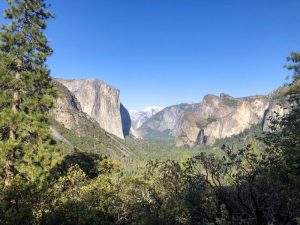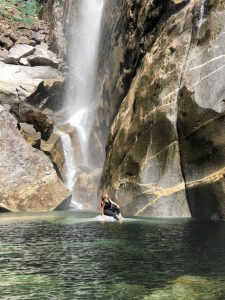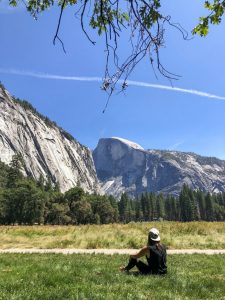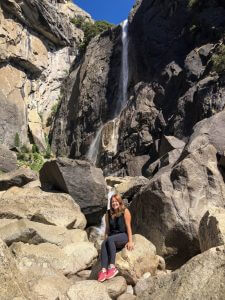By Amanda Lawrence.
Yosemite Falls is located in Yosemite National Park in California, USA, and it is one of the most beautiful National Parks in America. In 1884, famed poet John Muir wrote poems and spoke about the Sierra Nevada, which helped to create and preserve this stunning landscape as a National Park. Yosemite has many hiking trails, climbing, camping, swimming, bird watching, and many other excellent ways to explore the wilderness. I will tell you all you need to know before you hike the Yosemite Falls Trail specifically.

Getting There
Most visitors arrive from around the USA and abroad through an international airport. Yosemite National Park is 268km (167miles) outside of San Francisco and 233km (145 miles) from Sacramento, both of which have international airports. When booking your tickets, be sure to book them far in advance as availability and prices skyrocket closer to your travel date and during the peak season. Booking a flight from the top booking sites recommended by Fidis Travel can also help you stay on budget!
It is recommended to drive to Yosemite National Park due to the distance from both airports, but there are intercity buses and trains like Greyhound and Amtrak that run from the nearby cities to Yosemite.
Getting around Yosemite
If you are planning on driving to Yosemite during peak season, it is a good idea to head to Yosemite early, park your car and take the local park shuttle that brings you around to many of the park’s trailheads (including Yosemite Falls), food, and campgrounds.
If you continue to drive, be aware that finding parking later in the day can be extremely difficult if you plan to hike more than one trail.
Best time to visit:
Yosemite is open all year round, with some minor closures and limited road access during the winter months (November-May). It is best to check with the Yosemite National Park website for any road closure notifications or other weather statements that might impact your hike.
Each season in Yosemite has its benefits and drawbacks, but the general consensus is that the best time to Visit Yosemite National Park is in May or September, when the park is accessible but not too crowded.
Winter (November to March)
Wintertime in Yosemite can be a magical experience as snow blankets the trees and mountains, and icicles form in the tunnels. It can be a beautiful experience with minimal crowds and a unique opportunity to see this popular tourist destination almost empty.
If you want to hike in Yosemite during the winter, you should be an experienced hiker with plenty of winter hiking and survival skills under your belt. The downside to hiking here in the winter is the limited road access and facility closures that can make planning and hiking quite difficult. It’s always best to be prepared!
Spring (March-June)
Visiting the park in spring is wonderful! You can see the leaves that are just returning to the trees, and the newly melted snow causes cascades of water to flow over the 25 waterfalls that can be found in Yosemite. Depending on where you choose to hike, there can still be road closures and facility closures, but it is considerably easier to hike in spring than in winter. Towards the end of spring and the beginning of summer, you will see the hoards of tourists returning to Yosemite, but the trails are usually not that crowded.
Summer (June-August)
Summertime is when you will see Yosemite in full swing, with most roads and all facilities open to the public. This is when all the trails are open, and it is most busy. It is easier to avoid getting lost because of the crowds of people, but it can make hiking some of the trails more difficult. This is also the hottest month, and hikers should carry lots of water and sun protection. Hikers should still check the park website to stay current on any potential forest fires or bear sightings that are common in the area.
Fall (September- November)
When the weather starts to cool, and the leaves fall to the ground, hikers still flock to Yosemite. The cooler weather is more enticing than the blazing hot California summers, and the facilities and roads remain mostly open and easy to use. There will be fewer visitors than in summer but still a considerable amount so that you won’t be completely alone on the trails!
Main attractions/must-do’s:
Yosemite has so many things to do it would be hard to list them all in one article! There are a few experiences in Yosemite that everyone should have at least once!
- See the panoramic view from Tunnel View as you enter the park
- Climb Half Dome (if you’re brave enough!)
- Hike to the top of Yosemite Falls
- Camp under the stars
- See the sweeping views at Glacier Point
- Marvel at El Capitan
- Experience peace and get close to nature in Tuolumne Meadows
About the trail
Yosemite Falls Trail is actually split into two different trails: lower and upper. Lower Yosemite Falls is a 1.9-km loop trail that is considered relatively easy and well-maintained. This trail brings you to the bottom of Yosemite falls and is extremely popular with visitors due to how accessible it is.
Upper Yosemite Falls is a 12.2-km out-and-back trail that is rated as hard. This trail brings you up to the top of Yosemite falls and gets you up close and personal with the waterfall. You will also be rewarded with panoramic views of the valley! Although it is considered one of the more demanding hikes in the park, it is among the most rewarding.

Things to bring
It is important to come prepared for any hike, no matter where you are going, but the Yosemite Falls trail takes some special consideration! Here is a list of gear to bring on the Yosemite Falls trail!
- First aid kit
- At least 2L of water
- Food (high protein snacks and one meal)
- Hat, sunscreen, buff, and other sun protection
- Bear spray
- Hiking boots/shoes
- Hiking poles
- Backpack
- Fully charged phone and battery pack
- GPS
Things that make this experience unique:
Yosemite Falls is by far the tallest waterfall in the park at over 2,425 feet and of the highest waterfalls in the world. When hiking this trail, you get to ascend to the top of the falls, seeing sweeping views of Half Dome, El Capitan, and Yosemite Falls as you climb!
In the summer, when the waterfall starts to slow, you can actually take a swim at the bottom of the Falls using the Lower Yosemite Falls trail (1.9-km loop) to get there!
Things Visitors should be aware of:
There are many things to be aware of when visiting Yosemite National Park. Here are some of the most important:
- Be prepared for the weather, possible animal encounters, and hiking conditions
- It is best to be aware that for most of the year, Yosemite experiences heavy traffic (cars, people, etc.). Don’t expect to be alone on the trails!
- A reservation is required to drive into or through Yosemite National Park from 6 am to 4 pm daily.
- There is a car entrance fee that is valid for seven days (except May 20 through September 30, 2022, when it’s valid for three days).
- Reservations for campsites should be made well in advance
- Backcountry hiking/camping and Half Dome require permits.

Budget considerations:
Visiting Yosemite National Park can seem like a budget-friendly thing to do, but the unexpected costs can add up fast. Camping in the park can cost over 30$/ per night, and eating in the park can be quite expensive. If you book your site far in advance and bring your own food, staying in the park is the most budget-friendly option.
Staying in the park has many other benefits. You will get to meet many other hikers and people visiting the park, who usually stay for a long time and create a little community. It is fun to have campfires and sing songs, just don’t forget your marshmallows and guitar! Be sure to bring a guitar made for traveling.
Staying outside the park and driving in will cost you significantly more, as hotels and Airbnbs in the nearby area are considerably more expensive. Add in the fuel costs, and this can eat up a lot of your budget. There is a one-time entrance fee valid for 7 or 3 days (depending on the time of the year).
Booking your accommodations/car rentals very far in advance and packing your own food is your best way to beat the high prices that are associated with visiting Yosemite National Park.

Reviewers rating out of 10:
Overall I would give the Yosemite Falls trail a 9.6/10 for the adventure and once-in-a-lifetime views! It is a unique hike that everyone should experience. Whether you visit the lower falls or tackle the difficult upper falls, it is a great way to spend a day in Yosemite National Park.
Location-relevant websites:
https://www.nps.gov/yose/index.htm

Amanda Lawrence
Amanda is a travel enthusiast and writer who helps others have off-the-beaten-track travel experiences through her informative and insightful articles.
Amanda likes to find hidden gems and travel on a strict budget while getting up close with nature and the cultures in a destination. When she isn’t writing about travel, she enjoys hiking, camping, and skiing in the North Mountains of Vancouver.














Leave a Reply